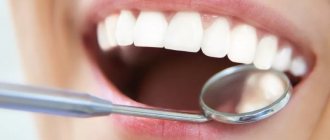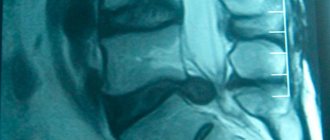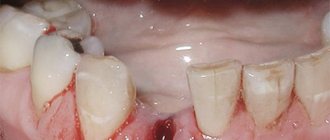Alveolitis is an inflammation of the socket (alveoli) left after tooth extraction. This pathology does not always develop; its development depends on many factors. The disease is characterized by severe pain in the area of the hole formed after surgery, general weakness, fever, headache, enlarged submandibular lymph nodes, bad breath and other unpleasant symptoms.
Alveolitis is not only physically painful, but also a dangerous disease. In the absence of proper treatment for several days, the inflammatory process can result in limited osteomyelitis, purulent melting of the jaw bone, and then surgical intervention will be required again.
With timely diagnosis of pathology and proper sanitation of the socket, the treatment prognosis is favorable. The main thing is to detect the symptoms of the disease in time and begin to treat it.
Classification
Depending on the nature of the healing of the hole, dentists distinguish several main forms of dental alveolitis:
- Serous. The initial stage of the disease usually appears 2–3 days after tooth extraction. This form is characterized by continuous pain that worsens while eating. Although the patient does not yet complain of feeling unwell, his lymph nodes are not enlarged, but he already feels that the disease is progressing.
- Purulent. If the serous form of alveolitis is not treated, the disease turns into a purulent form. Most often it is diagnosed 6–7 days after tooth extraction. The painful sensations can no longer be ignored, the pain intensifies, radiating to the ear or temple. Exploring the affected area also causes severe pain. Purulent alveolitis is characterized by a dirty gray coating inside the socket, significant swelling around the wound, thickened alveolar process and other problems. The patient's general health deteriorates significantly. Lymph nodes enlarge and become painful on palpation. Often the patient cannot even eat or open his mouth.
- Hypertrophic. At this stage, the symptoms of the disease subside. The patient notes a decrease in body temperature, improved well-being and decreased pain. However, at the hypertrophic stage, dangerous tissue proliferation occurs, which is clearly visible upon examination. When touched, pus is released from the inflamed area, and the mucous membrane acquires a bluish tint.
Ask a Question
Getting rid of unpleasant odor
If you can’t visit a doctor within the next few days, you can try to remove bad breath on your own. The measures are aimed at reducing the spread of pathogenic flora in the mouth. Hygiene measures are carried out longer than the required time - 5-7 minutes instead of 3-4. Particular attention is paid to the interdental spaces, where the greatest amount of plaque accumulates. It is recommended to use brushes, irrigators or dental floss along with the brush and paste. Careful hygiene prevents the spread of infection deep into the soft tissues of the alveoli.
After each meal, the mouth should be rinsed with antiseptic solutions. This is necessary in order to prevent a foreign object from entering the wound. Solutions can be purchased at a pharmacy or prepared independently at home. Preference is given to herbal solutions or plain boiled water.
Alcohol tinctures are not used to rinse the mouth after tooth extraction, as they can cause burns to damaged tissues. Decoctions can be prepared from chamomile, calendula, mint or lemon balm
If a putrid odor appears from the mouth, it is recommended to stop consuming protein foods (meat, fish). Preference is given to fresh vegetables and fruits. After each snack, chew gum.
During hygiene procedures, the back of the tongue is also cleaned, since the vast majority of pathogenic microorganisms are concentrated on it. Before visiting a doctor, you can soak a cotton swab in an antiseptic composition and apply it to the problem area. In case of severe bleeding, a tampon with hydrogen peroxide is applied to the wound area. Lotions using novocaine or lidocaine help reduce the intensity of pain.
Medicinal solutions for rinsing
To prevent foul odor from the mouth after tooth extraction, the following antiseptic compositions should be used:
- Furacilin solution. Prepare the product yourself: dissolve 2 tablets of the drug in 1 glass of boiling water and leave until cool. The product has a powerful anti-inflammatory and antiseptic effect. Furacilin is recommended for purulent complications and severe inflammation of the gums.
- Chlorhexidine solution. Prevents the development of purulent lesions.
- Miramistin. It eliminates bad breath well and prevents the formation of pus in the socket.
Rinse your mouth carefully so as not to wash the clot out of the hole. It is advisable to simply hold the antiseptic solution over the problem area. Measures to treat the oral cavity are carried out 24-48 hours after extraction. At least 6 hours must pass between procedures. Avoid rinsing your mouth if there is a cotton swab soaked in an antiseptic in the hole. You should also not remove the tampon yourself.
When providing emergency care, it is important to remember that some home procedures can be hazardous to health. Many patients rush to use saline or soda solutions after tooth extraction. Doctors speak out against the use of such drugs. The components disinfect the hole well, but also contribute to the destruction of the clot. Illiterate self-medication can only aggravate the situation. The well should not be touched after removing the element, even if the clot is dark in color and has a bad smell.
Traditional medicine is used in combination with medications. List of effective recipes to eliminate bad breath from the mouth:
- Sage decoction and oak bark: 2 tbsp. l. of herbal ingredients, pour 200 ml of boiling water and leave until cool. Use hot solutions to treat the mouth. Warming up stimulates the activity of pathogenic bacteria.
- Fresh leaves of golden mustache. The leaf of the plant is crushed until the juice appears and diluted in a 1:1 ratio with boiled water. The medicine is used twice a day after tooth extraction.
- Eucalyptus. It not only freshens breath, but also reduces the intensity of inflammatory processes.
If no results are observed from home treatment within 2-3 days, then you should urgently consult a doctor. Do not forget that emergency measures are considered only as temporary methods for eliminating unpleasant signs after tooth extraction.
Causes of inflammation
The disease can develop only after tooth extraction. Most often, the hole formed after removal heals within a day after the operation, and the patient feels better. But if the blood clot that covers the open wound moves or becomes deformed, an infection can penetrate into the hole, in which case alveolitis of the gums develops. As a result, the surface of the wound heals for a long time, and the patient suffers from complex discomfort.
Predisposing factors for the development of inflammation:
- Surgical injuries during complex removal. The more complex the operation, the more pronounced the postoperative inflammation of the bone tissue will be, and the more likely the release of direct plasminogen activators.
- Complex extractions associated with tooth segmentation, osteotomy, detachment of the mucoperiosteal flap. Complex operations increase the chance of developing alveolitis 10 times.
- Removal of wisdom teeth. The denser, less vascularized bone tissue adjacent to the figure eights is prone to the formation of dry sockets.
- General diseases of the patient. Alveolitis often occurs against the background of concomitant diseases. For example, patients with diabetes mellitus or immunocompromised patients are more susceptible to alveolitis due to impaired healing processes in the tissues.
- Taking oral contraceptives. The estrogen contained in these drugs may indirectly enhance the fibrinolytic process, causing the breakdown of the blood clot.
- Smoking. The direct connection between smoking and alveolitis has been repeatedly proven clinically. According to studies, the risk of socket inflammation in smokers increased 4-5 times compared to non-smokers. The incidence increased by more than 20% in patients who smoked 1 pack per day and by 40% in patients who smoked immediately before and after surgery.
- Dislocation of a bunch. If the socket is handled carelessly and there is negative pressure (for example, due to drinking through a straw), alveolitis may develop.
- Bacterial infections. Dentists agree that bacterial infections are the main risk factor for dry socket.
- Poor oral hygiene. The incidence of alveolitis increases significantly with poor oral hygiene.
- Excessive use of local anesthetics. According to some studies, excessive use of an anesthetic with a high concentration of a vasoconstrictor can provoke ischemia and make it difficult for the socket to fill with blood. This condition also increases the risk of alveolitis.
In fact, alveolitis is a fairly rare disease. According to statistics, it affects approximately 3% of patients who have undergone tooth extraction surgery. More often than not, the socket is not formed properly when lower incisors and molars are removed.
But alveolitis is especially common when removing lower wisdom teeth: according to experts, in approximately 20% of cases, the removal of “eights” with difficult eruption is complicated by alveolitis. In addition, it is believed that the risk of developing the disease is inextricably linked with age. This is explained by the fact that metabolism slows down, immunity is weakened, and the regenerative abilities of the body deteriorate.
Treatment of pericoronitis
Treatment by a dentist and surgeon should be aimed not only at eliminating the symptoms of the disease, but also at eliminating its causes. As a rule, for wisdom tooth pericoronitis, drug therapy and surgical intervention are used.
Drug treatment is the fight against microorganisms that caused the development of the infectious process. The doctor also prescribes medications that reduce pain and inflammation symptoms.
As a rule, the following groups of drugs are used to treat wisdom tooth pericoronitis:
- antiseptics, mouth rinses. The products reduce the microbial load and wash away bacterial and purulent particles.
- nonsteroidal anti-inflammatory drugs, for example, Ibuprofen, Ketorolac.
- antimicrobial, broad-spectrum anti-inflammatory drugs, for example, Amoxicillin, Amoxiclav, Azithromycin.
Surgical intervention for wisdom tooth pericoronitis usually involves excision (removal) of the gum hood over the wisdom tooth. This tactic is chosen in case of frequent relapses of the disease, pronounced pain syndrome, and spread of the purulent process to surrounding tissues. When an area of soft tissue is excised above the surface of the crown, plaque stops accumulating, which prevents infection and progression of the disease.
Excision of the hood takes no more than 10-15 minutes and is performed under local anesthesia.
If removing the hood and conservative treatment does not lead to an improvement in the condition, it is possible to remove the wisdom tooth. Removal is also carried out in case of incorrect tooth position or significant deviation of the “figure eight” from its physiological axis. In rare cases, not only the wisdom tooth is removed, but also part of the bone tissue. After removal, in almost 100% of cases, the patient recovers completely.
It is worth noting that many patients often insist on maintaining the “eight”. Many believe that in the future a wisdom tooth may be useful if prosthetics are needed. However, such an opinion is wrong. The wisdom tooth is located the farthest away and does not bear a significant functional load, taking only 2% of the total load on the dentition. When installing a crown, the wisdom tooth will not withstand the pressure, and the prosthesis will have to be replaced very soon.
Symptoms of alveolitis
As a rule, the patient ignores the first symptoms of inflammation without due attention, considering them to be the norm after surgery. After tooth extraction, as already noted, pain within 24 hours is considered normal. As the hole heals, the pain subsides and completely disappears after a few days.
If the patient develops an inflammatory process, then the unpleasant sensations do not subside after a day or two, and 3–5 days after the operation, severe, throbbing pain in the socket occurs, which intensifies as the infection develops.
With alveolitis, patients may complain of both unbearable and moderate pain. Pulsation and pain are focused, as a rule, only in the removal area. However, in rare cases, the pain radiates to half of the face.
Other characteristic symptoms of alveolitis are:
- a sharp rise in body temperature;
- tooth sensitivity to hot/cold food;
- enlargement of the submandibular lymph nodes;
- decreased appetite;
- increased salivation.
In rare cases, the disease causes weakness, increased fatigue, and secondary infectious foci appear on the oral mucosa.
How does alveolitis occur after tooth extraction?
The alveolus of a tooth is the hole in which its root is located. After removal, an open wound remains at the site of the tooth, and if the surgeon is inexperienced or the roots of the tooth have a complex anatomy, the tissues are further injured. We do not feel any discomfort during this procedure due to anesthesia. But after a couple of hours, when its effect ends, pain appears at the site of the extracted tooth, and the alveolus is slightly inflamed.
As a rule, after a day or two, the discomfort disappears, the wound heals, and the hole begins to heal well. However, this does not always happen. Sometimes in the area of the extracted tooth the inflammation only intensifies over time, and the pain worsens. Such symptoms are characteristic of alveolitis - an inflammatory process that occurs when an infection enters the hole and requires treatment by a dentist.
Diagnostics
The main symptom of the disease is the appearance of acute pain, which does not subside either 24 hours or 2–3 days after tooth extraction. Sometimes a dentist can identify chronic alveolitis during routine oral examinations. In this case, an empty socket without granulation tissue appears in place of the impacted tooth. The bone is already visible at the bottom of the hole.
The dentist will be able to determine the presence of tissue changes during the examination; radiography and radiovisiography of the affected area may also be prescribed.
Tip two: on the first day, refuse even mouth baths.
Many patients are worried that on the first day after surgery, doctors forbid them not only from brushing their teeth and actively rinsing, but even from using antiseptic mouth baths. They fear that inaction will lead to infection of the newly damaged tissue. However, you don't have to worry about this. After treatment, the doctor tampons the resulting hole with iodoform turunda (for example, Alvostaz), which then gradually resolves over 4-5 hours. The dressing has a local antiseptic, hemostatic, anti-inflammatory1, wound healing and even anesthetic effect.
The bandage has a local antiseptic and hemostatic effect
By the way, the iodine smell after tooth extraction and even a similar taste is just the norm when you have such a medicinal dressing on the wound. This is harmless, unless, of course, you are allergic to iodine, which your doctor should naturally ask about in advance. After a day, the smell and taste will completely disappear, because... the remedy will dissolve.
For the first 3-5 days, under no circumstances should you actively rinse your mouth with antiseptic solutions or herbal decoctions. Moreover, it is not even recommended to do mouth baths on the first day. All this can lead to damage, shifting or loss of the protective clot.
Starting from the second day after removal, you can perform oral baths. To do this, simply put an antiseptic in your mouth (Chlorhexidine, Miramistin, Furacilin), hold it for several minutes, then carefully spit it out. But you cannot use a soda-salt solution for this purpose - despite its excellent disinfecting properties, it can negatively affect the clot itself and the tissues surrounding it.
"Chlorophyllipt" can also be used for rinsing
Treatment of alveolitis
When the socket becomes inflamed, the main thing is to eliminate the source of infection, prevent the development of inflammation and preserve the dentition. In order to alleviate the patient’s condition, the dentist uses the following therapy methods:
- Mechanical cleansing of the hole, washing out purulent residues with a solution of nitrofural or hydrogen peroxide.
- Anesthesia of the hole. The pain syndrome is relieved with the help of local applications with anesthetics and analgesics. To do this, the doctor applies the lotion for half an hour and then removes it to prevent the proliferation of microbes in the area. The dentist will advise the patient to repeat the procedure several times a day. Taking painkillers orally is not recommended.
- Taking antibiotics. In the presence of concomitant diseases, alveolitis is treated with antibiotics.
With the right approach, the signs of alveolitis subside 2-3 days after the start of treatment. If therapy was not started on time, residual pain may drag on for 2–3 weeks.
With the permission of the dentist, additional treatment of alveolitis with folk remedies is possible:
- Sage rinses. To prepare the solution, brew a large spoonful of dry sage in 250 ml of boiling water, leave the mixture for an hour, wrapping the container in a towel. After this, the liquid should be filtered and used for rinsing.
- Gargling with chamomile flowers. To prepare the composition, brew a large spoonful of chamomile flowers in a glass of water for 15 minutes, insulating the container with a towel. The infusion should be strained and rinsed your mouth up to 12 times a day.
- Poplar buds. To prepare, take half a glass of buds, pour into a glass container and pour in 500 ml of vodka. The product should be infused for 10 days in the dark and cool, then filtered, soaked in cotton swabs and applied to the inflamed area.
- A soda rinse solution can also be an effective addition in the treatment of alveolitis. You should take a large spoonful of powder in a glass of warm water or mix soda with water to obtain a paste-like mass, which then needs to be used to treat the hole.
- Burdock leaves. To prepare a medicinal decoction of burdock leaves, you need to pour 20 grams of raw material with 2 glasses of water, and then simmer the mixture over low heat for about 40 minutes. The resulting solution should be cooled and filtered, and then used for rinsing.
- Aspen bark. Pour 1 tablespoon of crushed aspen bark into one glass of boiling water. It is important to leave the solution in an airtight container for 3 hours, and then use 100 ml of strained warm liquid at least 3 times a day.
- Anise infusion. To prepare the infusion, pour 1 tablespoon of anise into 200 ml of boiling water, and then keep in a thermos for 50 minutes. The liquid should be filtered and used to rinse 3 times a day.
Symptoms for an urgent visit to the dentist
When such an unpleasant symptom as pain and bad breath intensifies, the temperature rises, the gums swell, and dental surgery may even be required. It is important to see a dentist on time.
- The doctor will carefully examine the oral cavity and the surgical area.
- A small spoon is used to diagnose the hole.
- If alveolitis develops, special therapy is prescribed. First, anesthetics are introduced, then plaque and pathogenic microbes are removed.
- Then the wound is treated with an antiseptic, and the necessary medications are applied.
- Stitches may be needed.
You should contact the dentist when the gum tissue is swollen, you feel severe pain, your cheek and neck are swollen. In such a situation, pus collects in the wound area. The dentist prescribes rinsing, disinfection procedures, painkillers, and antibiotics. With severe tissue injury, an abscess may develop. At risk are those patients who do not follow the doctor’s recommendations. Remember that timely contact with a doctor is the key to quick treatment.
Prevention
The best prevention of pathology after tooth extraction is to be attentive to yourself and follow all the surgeon’s recommendations. While the hole is healing, give up bad habits, eating too hot, spicy, sweet foods, and if possible, switch to pureed foods. And if you suspect inflammation, contact your dentist as soon as possible.
Under no circumstances should the first symptoms of alveolitis be ignored. Against the background of inflammation, more serious problems may arise:
- Phlegmon is an acute diffuse purulent inflammation.
- An abscess is a purulent inflammation of tissues with their melting.
- Osteomyelitis is a purulent-necrotic process that can develop in the bone and bone marrow, as well as in the surrounding soft tissues.
- Periostitis is inflammation of the periosteum.
- Sepsis is a severe systemic inflammatory reaction.
- Tissue necrosis is local tissue death.
Modern methods of treating alveolitis make it possible to quickly relieve the symptoms of inflammation and avoid the complex consequences of the disease. The sooner the patient consults a doctor, the less likely it is to develop complications.
Tip three: limit your consumption of certain foods
To prevent an unpleasant odor from appearing from the socket after tooth extraction, everything must be done to ensure that the protective clot in the wound remains intact. And dietary habits in the first few days play an important role in this.
“After removing my wisdom tooth, I had a terrible smell from the socket. It just smelled like some kind of rot, but the hole was still huge after the operation. There was no pain. I went to the doctor to find out what was wrong, because at work our tables are very tightly spaced, and I’m sure that all my colleagues could easily smell this stinking smell. The doctor cleaned something there, and the stench went away immediately. It turned out that food was clogged into this deep hole, and this food was rotting, and I was unable to clean it out on my own. Now I’m afraid that I might get full again, I can’t imagine how to eat until all this drags on. I’ll chew for a week on only one side of my jaw...”
Anna, review from 32top.ru
You cannot eat for the first 2 hours after surgery, but after half an hour you can already drink water. It is better to avoid eating cold, hot and solid foods for 2-5 days. You also need to exclude spicy and salty foods from your diet, because they can cause additional discomfort, irritation of damaged mucous membranes and slow down the healing process.
After the procedure you need to take soft, warm food
You should not consume foods and drinks that increase blood flow to the head and increase blood pressure: coffee, pepper, pomegranate, garlic, cinnamon, citrus fruits, ginger. Alcohol is prohibited. Such foods and drinks can cause swelling and bleeding, which will wash away the protective clot.
In the first days, give preference to soft, liquid and warm foods. Chew on the side of the jaw opposite the one where surgery was performed.
If your doctor suggests removing a tooth, consider immediately replacing it with an implant. Today there is a one-time method of implantation - you do not have to wait for the hole to heal. True, if the specialist’s recommendations are violated, an unpleasant odor after tooth extraction and simultaneous installation of an implant can also occur, but not against the background of alveolitis, but against the background of peri-implantitis.
Treatment of alveolitis in STOMA clinics
Surgeons at STOMA clinics are required to examine patients and give recommendations on how to care for the hole formed after tooth extraction. If problems arise after extraction, the patient can always call the clinic and clarify whether inflammation has really begun and what to do to reduce pain.
At any time after removal, the patient can contact our clinics. The attending surgeon will examine him and prescribe appropriate therapy.
Feel free to call us at any time and consult about your condition. The sooner we start treating alveolitis, the lower the risk of complications.
Alveolitis photo of the hole
Often the hole may look normal, that is, without pronounced deviations, but this can be seen in the photo. But here you can consider the presence of a narrow inlet. It is also not very clear whether a clot is present in this case. Of course, making a diagnosis under such circumstances is very difficult. To do this, the doctor will have to conduct a full examination, which is performed using modern technology. And only because of the constant, very often in the form of increasing pain, smell from the open socket, tumor of the gingival tissue, can alveolitis be suspected.











